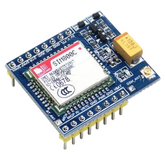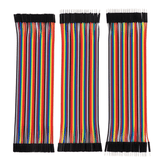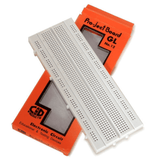Getting Started with SIM800C and Arduino
Summary
Unlock the potential of your Arduino projects with our comprehensive guide on using the SIM800C GSM module. This blog covers everything from an engaging introduction to step-by-step instructions on using the SIM800C. Learn about the essential components, detailed connection setup, and the necessary Arduino code to get your project running. Explore various practical applications of this powerful module. Perfect for both beginners and seasoned tinkerers, this guide will elevate your DIY electronics skills. Click now to transform your Arduino projects with SIM800C!
INTRODUCTION
In today's interconnected world, incorporating communication capabilities into the electronics projects can greatly improve their functionality. GSM/GPRS modules like the SIM800C provide a flexible and economical substitute for communicating with and sending notifications, accessing data remotely, and operating devices via SMS.
The following blog post will demonstrate the interfacing of the SIM800C with the frequently utilized Arduino UNO R3 microcontroller board. To get you started, we'll briefly go over the required hardware connections, software setup, and example code.
Towards the end of this blog, users will be able to incorporate robust communication functionality into Arduino projects, creating a plethora of opportunities for data transmission, remote control, and monitoring. With the help of this blog, users may utilize the SIM800C module with the Arduino UNO R3 to come up with innovative ideas, irrespective of whether you are an enthusiast, student, or professional developer.
Browse the best collection of Original Arduino Kits.
HOW TO USE SIM800C
The SIM800C is a compact, low-power, and versatile GSM/GPRS module developed by SIMCom, a pioneer in wireless communication technology. The SIM800C serves as a quad-band GSM/GPRS network-compatible embedded application that can be deployed across the globe.
The primary applications include calls through the phone, SMS messaging, and data transmission through GPRS, which facilitates connectivity for devices.
The key features include:
- Size: The SIM800C is suitable for applications where space is a primary constraint due to its only measures 17.6 x 15.7 x 2.3 mm size.
- Low Power Consumption: It is appropriate for battery-operated electronic devices due to its low power consumption design.
- Adaptable Networking: The module provides a simple approach to integrate into a variety of IoT projects by offering conventional UART interfaces and supporting TCP/IP and HTTP protocols.
- Quad-Band Support: Functioning at frequencies like 850/900/1800/1900 MHz, the SIM800C provides a worldwide compatibility with GSM networks.
- Additional Features: The SIM800C supports Bluetooth, FM radio, and analog audio interfaces in addition to the standard means of communication.
COMPONENTS REQUIRED


SIM Card with activated data plan

- Breadboard (Optional)

Computer with Arduino IDE software
CONNECTION SETUP OF GSM MODULE WITH ARDUINO
Let's start by connecting the SIM800C module with Arduino Uno. The SIM800C can be directly interfaced with the digital pins present on the Arduino Uno. It operates at a lower voltage level (3.3V) and is capable of withstanding 5V.

The pins can be connected as follows:
- SIM800C VCC -> 5V Arduino Uno
- SIM800C GND -> GND Arduino Uno
- SIM800C TXD -> Digital Pin 8 of Arduino Uno
- SIM800C RXD -> Digital Pin 7 of Arduino Uno
ARDUINO CODE
#include
#define SIM800_TX_PIN 8
#define SIM800_RX_PIN 7
//Create software serial object to communicate with SIM800
SoftwareSerial serialSIM800(SIM800_TX_PIN, SIM800_RX_PIN);
void setup()
{
Serial.begin(9600);
serialSIM800.begin(9600);
delay(1000);
Serial.println("Setup Complete");
}
void loop()
{
//Read SIM800 output and print it on serial monitor
if(serialSIM800.available())
{
Serial.write(serialSIM800.read());
}
//Read Serial Monitor inputs if available and send them to SIM800
if(Serial.available())
{
serialSIM800.write(Serial.read());
}
}
- Upon connecting the Arduino UNO, launch the Arduino IDE, write the program, select the appropriate board and the COM port, and upload the sketch.
- Open the serial monitor and you should be able to get the messages as mentioned in the code.
- Next, you may type "AT" in the Serial monitor. "OK" is expected in the serial reply if there is no SIM card present. The response "OK" would be followed by "Call Ready" and "SMS Ready" if a SIM card is present and further proceed to input the AT commands.
APPLICATIONS
The SIM800C is a flexible GSM/GPRS module that is extensively utilized in many different wireless communication projects. Several applications can be rendered possible when used alongside the Arduino Uno. Here are a few essential applications.
- VOICE COMMUNICATION
Used in call-based control systems to place and receive calls in order to initiate actions or get device status updates.
Used for developing basic intercom systems that facilitate communication in small areas.
- PROJECTS BASED ON SMS
To remotely work devices, send SMS commands. For instance, turning on and off other appliances or lights.
Receive SMS notifications when there are certain changes in temperature, intrusions, or other sensor data.
Through SMS, users can remotely operate their houses and control various appliances.
- INTERNET OF THINGS (IoT)
Gather the data from the sensor and use GPRS to log it to a remote server or database.
Utilized in smart agriculture to track temperature, moisture content, and other factors and then transmit data for analysis to a central server.
- SECURITY SYSTEMS
When a security sensor is triggered, send an SMS or place a call.
Connect cameras or motion detectors to the network to deliver alerts in real time and perhaps even video feeds.
- GPS TRACKING SYSTEMS
Track vehicles in real time by using GPS with SIM800C to provide location information via GPRS.
Build personal trackers that notify a designated phone number or server regarding your whereabouts.
- PAYMENT SYSTEMS
Deploy payment systems that can handle GSM network transactions, these will be beneficial in places where internet service is unreliable.
Provides options for vending machines to accept payments by GPRS or SMS, or to send restock alerts.
- HEALTH MONITORING SYSTEMS
Send health data to a server or healthcare practitioners directly from wearable devices, such as blood pressure or heart rate.
In case of emergencies, it can be used to automatically send the alerts along with the details of the location.
- WEATHER STATIONS
Send meteorological sensor data such as pressure, temperature, and humidity, to a server for instantaneous tracking and analysis.
Broadcast warnings about frost or strong winds, extreme heat waves based on the weather.
- ASSET TRACKING
Monitor the whereabouts and condition of resources and automobiles to enhance routes and guarantee effective fleet administration.
Establish alerting systems in case an asset is transferred without warning.
- SMART METER
Utilized to send data for analysis and billing from gas, water, or electricity meters to a central server.
Permit utility firms to remotely manage supplies using data that is updated in real time.
CONCLUSION
Ultimately, there are numerous opportunities to incorporate cellular communication capabilities into your projects as you integrate the SIM800C GSM/GPRS module with the Arduino UNO.
Featuring the potential to send and receive SMS messages, place phone calls, and surf the internet, this potent combo expands the functionality as well as connectivity of the Arduino projects.
The applications are plenty and diverse. They include data logging, emergency response, home automation, and vehicle tracking in addition to remote monitoring systems. You can develop innovative approaches that function outside of local networks and offer real-time data and control capabilities by utilizing the SIM800C.
The Arduino community offers an array of support, thereby rendering setting up the SIM800C with an Arduino UNO trivial. You can have your projects communicating with the outside world with a few lines of code and the appropriate connectors. Developing intelligent, connected applications will be rendered possible with the SIM800C and Arduino UNO as the Internet of Things (IoT) grows. Their low cost and simple operation render them ideal for both deployment and exploration.
The combination of the SIM800C and Arduino UNO is a potent tool for modern applications that demand dependable and extensive connectivity, laying the foundation for linked technology's future.










